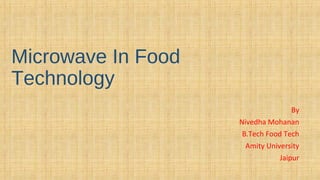
microwave in food
- 1. Microwave In Food Technology By Nivedha Mohanan B.Tech Food Tech Amity University Jaipur
- 3. Microwaves: Properties General •Electromagnetic waves of radiant energy •Wavelength: 0.025-0.75(m) •Frequency: 20,000-400(MHz) Specific to Food Applications: •Frequency Approved for Food Application: 2450MHz & 915MHz •Reflected by metals, pass through the air, absorbed by several food constituents
- 4. • Absorbed material heated up to the extent of absorption. Microwave loses heat in the process. • Loss factor and loss tangent used to define the loss of Microwave energy. • Materials that are highly absorbent of microwaves are called ‘highly lossy’ materials. • Loss Factor is also a measure of the degree of the penetration of the microwave. The greater the loss, the more the heat produced and lesser the penetration. • According to these properties the microwave frequency is chosen.
- 5. Mechanism of Microwave Heating • Microwave reverses its directions corresponding to frequencies of either 915MHz or 2450MHz. • Food and certain other materials acts as dipoles. Ex: Water. • When microwaves pass through the food, water and other polar molecules try to along themselves with the electric field which changes at least 915 times a second. • This leads to intermolecular friction, which in turn causes heating. • As different components of food have different heating factors, it takes simultaneous conduction(solids) and convection(liquids) to equalize the distribution. • The conduction and convection are the secondary effects while intermolecular frictional heat is the primary effect.
- 7. Microwave & Conventional Heating: The Differences Conventional •A direct flame, heated air, etc used in the conventional heating. •Food molecules largely react from the surface inwards, producing a heating gradient. •This can lead to difference in the burning of food surface and interiors. Microwave •Microwaves penetrate up to a few centimetres of the food which heats the food uniformly. •Heat is passed in from surface by conduction but is generated quickly and uniformly throughout the mass. •Hence the moisture is boiled away internally.
- 8. • Microwave heating thus leads to no crusting and surface browning. • This is a limitation when a crust on the surface is desired. For ex, bread baking. • In such a case, the microwave heating is accompanied by or followed or preceded by a conventional heating methods.
- 9. Microwave Generators and Equipment • Most commonly used microwave generator is Magnetron. • It is a kind of electron tube within a magnetic field which propagates high frequency radiant energy. • Power output is measured in kwatts. Larger the power, better the heating. • Also, the weight of the food also determines the heating time of the food. • Simple Microwave oven is a metal cabinet into which the Magnetron is attached. • Food is attacked by the oven and thus the food gets heated from all forces.
- 11. • Complex microwave tunnel oven are equipped with an endless moving belt of low loss material on which food is conveyed past magnetrons. • Open at inlet and exit for transfer of food. • Trapping of microwaves is done by providing heat absorbing food which absorb any stray radiation. • Possible to heat liquid resources. Liquid maybe pumped through low loss coil of glass or kept near to microwave.
- 13. Microwave Food Applications • Baking Internal heating quickly achieves desired temperature throughout the product. Often combined with external heating. • Concentrating Permits concentration of heat sensitive solution and slurries at relatively low temperatures in relatively low time. • Cooking Microwaves cook large pieces without high temperature gradient between the surface and interior. Suited for continuously cooking of file.
- 14. • Curing Effective for glue line curing of laminates without direct heating of the laminates themselves. • Drying Microwaves selectively heat water with little direct heating of the solids. • Enzyme Inactivation Rapid uniform heating to inactivating control can control and terminate at enzymatic reactions. • Finish Drying Used to remove excess traces of water after using conventional heating without overheating the system.
- 15. References • All the data or text input is derived from the Food Science belonging to Food Science Text Series.